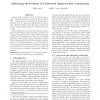Free Online Productivity Tools
i2Speak
i2Symbol
i2OCR
iTex2Img
iWeb2Print
iWeb2Shot
i2Type
iPdf2Split
iPdf2Merge
i2Bopomofo
i2Arabic
i2Style
i2Image
i2PDF
iLatex2Rtf
Sci2ools
NDSS
1999
IEEE
1999
IEEE
Addressing the Problem of Undetected Signature Key Compromise
Suppose that messages have been signed using a user's signature private key during the period of time after a key compromise but before the compromise is detected. This is a period of undetected key compromise. Various techniques for detecting a compromise and preventing forged signature acceptance are presented. Attack protection is achieved by requiring a second level of authentication for the acceptance of signatures, based on information shared with a trusted authority, independent of the signature private key and signing algorithm. Alternatively, attack detection is achieved with an independent sychronization with the authority, using a second factor adaptive non-secret parameter. Preventing forged signature acceptance subsequent to the detection is achieved by the use of a cooling-o or latency period, combined with periodic resynchronization.
Computer Networks | Key Compromise | NDSS 1999 | Signature Private Key | Undetected Key Compromise |
| Added | 04 Aug 2010 |
| Updated | 04 Aug 2010 |
| Type | Conference |
| Year | 1999 |
| Where | NDSS |
| Authors | Mike Just, Paul C. van Oorschot |
Comments (0)

